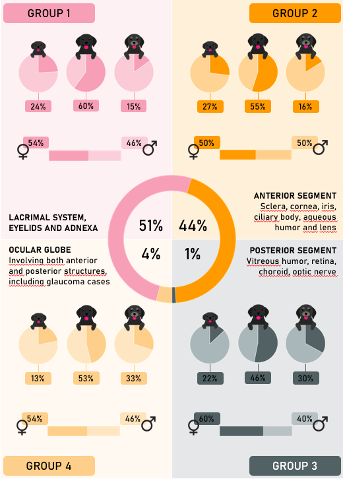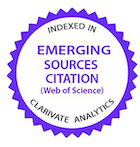Oftalmopathies in 574 dogs of the breed Shih tzus attended at the Veterinary Hospital: retrospective study
DOI:
https://doi.org/10.1590/1809-6891v25e-79326EAbstract
Brachycephalic dogs, such as Shih Tzu, are predisposed to the development of ophthalmic disorders due to their facial conformation. The main objective of this study was to investigate the primary ophthalmopathies in Shih Tzu dogs treated at the Veterinary Hospital between 2014 and 2022. A total of 1724 diagnoses were analyzed. Regarding gender, 51% (882/1724) were females and 49% (842/1724) were males. In terms of anatomical classification, diagnoses of group 1 (lacrimal system, eyelids, and adnexa) were the most prevalent, accounting for 55% (945/1724), followed by group 2 (anterior segment) with 40% (683/1724), group 4 (eyeball) with 4% (73/1724), and group 3 (posterior segment) with 1% (23/1724). The mean age at diagnosis was 5.2 years, with adult dogs being the most represented at 57% (979/1724), followed by young dogs at 22% (388/1724) and elderly dogs at 21% (357/1724). Elderly dogs had a higher likelihood of being diagnosed with glaucoma and cataracts compared to young and adult animals. In conclusion, the most commonly diagnosed conditions in Shih Tzu dogs were ulcerative keratitis, dry eye syndrome, distichiasis, entropion, and cataracts, with adult dogs being the most affected by these conditions, with no statistically significant difference between gender and the occurrence of diagnoses.
Downloads
References
Ekenstedt KJ, Crosse KR, Risselada M. Canine brachycephaly: anatomy, pathology, genetics and welfare. Journal of Comparative Pathology. 2020;176:109-115. Available at: https://doi.org/10.1016/j.jcpa.2020.02.008.
Packer RM, Hendricks A, Burn CC. Impact of facial conformation on canine health: corneal ulceration. PLoS One. 2015;10(5):e0123827. Available at: https://doi.org/10.1371/journal.pone.0123827.
Nutbrown-Hughes D. Brachycephalic ocular syndrome in dogs. Animal Companion. 2021;26(5):1-9. Available at: https://doi.org/10.12968/coan.2020.0056.
Castro SML, Bezerra RCF. Brazilian Cinophilia Confederation. In: Official Standard of the Shih Tzu breed. 2017.p.2-7. Portuguese. Available at: https://cbkc.org/application/views/docs/padroes/padrao-raca_200.pdf.
O'Neill DG, Lee MM, Brodbelt DC, Church DB, Sanchez RF. Corneal ulcerative disease in dogs under primary veterinary care in England: epidemiology and clinical management. Canine Genetics and Epidemiology. 2017;4:1-12. Available at: https://doi.org/10.1186/s40575-017-0045-5.
O'Neill DG, Brodbelt DC, Keddy A, Church DB, Sanchez R. Keratoconjunctivitis sicca in dogs under primary veterinary care in the UK: an epidemiological study. Journal of Small Animal Practice. 2021;62(8):636-645. Available at: https://doi.org/10.1111/jsap.13382.
Papaioannou NG, Dubielzig RR. Histopathological and immunohistochemical characteristics of vitreoretinopathy in Shih Tzu dogs. Journal of Comparative Pathology. 2013;148(2-3):230-235. Available in: https://doi.org/10.1016/j.jcpa.2012.05.014.
Kobashigawa KK, Lima TB, Padua IRM, Barros Sobrinho AAFD, Marinho FDA, Ortêncio KP, Laus JLO. Ophthalmic parameters in adult Shih Tzu dogs. Rural Science. 2015;45:1280-1285. Available in: https://doi.org/10.1590/0103-8478cr20141214.
Appelboam HP. Pug appeal: brachycephalic ocular health. Animal Companion. 2016;21(1):29-36. Available in: https://doi.org/10.12968/coan.2016.21.1.29.
Palmer SV, Gomes FE, Mcart JA. Ophthalmic disorders in a referral population of seven breeds of brachycephalic dogs: 970 cases (2008–2017). Journal of the American Veterinary Medical Association. 2021;259(11):1318-1324. Available in: https://doi.org/10.2460/javma.20.07.0388.
Sebbag L, Silva APS, Santos ÁP, Raposo ACS, Oriá AP. An eye on the Shih Tzu dog: ophthalmic examination findings and ocular surface diagnoses. Veterinary Ophthalmology. 2023;26:59-71. Available at: https://doi.org/10.1111/vop.13022.
Iwashita H, Wakaiki S, Kazama Y, Saito A. Breed prevalence of canine ulcerative keratitis according to depth of corneal involvement. Veterinary Ophthalmology. 2020;23(5):849-855. Available at: https://doi.org/10.1111/vop.12808.
Costa J, Steinmetz A, Delgado E. Clinical signs of brachycephalic ocular syndrome in 93 dogs. Irish Veterinary Journal. 2021;74(1):1-8. Available at: https://doi.org/10.1186/s13620-021-00183-5.
James-Jenks EM, Pinard CL, Charlebois PR, Monteith G. Evaluation of corneal ulcer type, skull conformation, and other risk factors in dogs: A retrospective study of 347 cases. The Canadian Veterinary Journal. 2023;64(3):225-234. Available at: https://europepmc.org/backend/ptpmcrender.fcgi?accid=PMC9979749&blobtype=pdf.
Gelatt KN, Ben-Shlomo G, Gilger BC, Hendrix DV, Kern TJ, Plummer CE. Veterinary Ophthalmology. 6th edition. Florida: John Wiley & Sons; 2021. 1082-1173p. English.
Rajaei SM, Faghihi H, Zahirinia F. The Shih Tzu eye: Ophthalmic findings of 1000 eyes. Veterinary Ophthalmology. 2024. Available at: https://doi.org/10.1111/vop.13182.
Sanchez RF, Innocent G, Mold J, Billson FM. Canine keratoconjunctivitis sicca: disease trends in a review of 229 cases. Journal of Small Animal Practice. 2007;48(4):211-217. Available at: https://doi.org/10.1111/j.1748-5827.2006.00185.x.
Deepika A, Nagaraj P, Kumar VA, Rani MU. Clinico-ophthalmic findings of corneal ulcers in dogs. International Journal of Veterinary Sciences and Animal Husbandry. 2023;8(5):220-224. Available at: https://www.veterinarypaper.com/pdf/2023/vol8issue5/PartD/8-5-25-645.pdf.
Bolzanni H, Oriá AP, Raposo ACS, Sebbag L. Aqueous tear assessment in dogs: impact of cephalic conformation, inter-test correlations, and test-retest repeatability. Veterinary Ophthalmology. 2020;23(3):534-543. Available at: https://doi.org/10.1111/vop.12751.
Gupta A, Heigle T, Pflugfelder SC. Nasolacrimal stimulation of aqueous tear production. Cornea. 1997;16(6):645-648. Available at: https://journals.lww.com/corneajrnl/citation/1997/11000/Nasolacrimal_Stimulation_of_Aqueous_Tear.8.aspx.
Gipson IK. Age-related changes and diseases of the ocular surface and cornea. Investigative Ophthalmology & Visual Science. 2013;54(14):ORSF48-ORSF53. Available at: https://doi.org/10.1167/iovs.13-12840.
Kitamura Y, Maehara S, Nakade T, Miwa Y, Arita R, Iwashita H, Saito A. Assessment of meibomian gland morphology by noncontact infrared meibography in Shih Tzu dogs with or without keratoconjunctivitis sicca. Veterinary Ophthalmology. 2019;22(6):744-750. Available at: https://doi.org/10.1111/vop.12645.
Sebbag L, Sanchez RF. The pandemic of ocular surface disease in brachycephalic dogs: The brachycephalic ocular syndrome. Veterinary Ophthalmology. 2023;26:31-46. Available at: https://doi.org/10.1111/vop.13054.
Jondeau C, Gounon M, Bourguet A, Chahory S. Epidemiology and clinical significance of canine distichiasis: A retrospective study of 291 cases. Veterinary Ophthalmology. 2023; 26(4): 339-346. Available at: https://doi.org/10.1111/vop.13091.
Yi NY, Park SA, Jeong MB, Kim MS, Lim JH, Nam TC, Seo K. Medial canthoplasty for epiphora in dogs: a retrospective study of 23 cases. Journal of the American Animal Hospital Association. 2006;42(6):435-439. Available at: https://doi.org/10.5326/0420435.
Park SA, Yi NY, Jeong MB, Kim WT, Kim SE, Chae JM, Seo KM. Clinical manifestations of cataracts in small breed dogs. Veterinary Ophthalmology. 2009;12(4):205-210. Available at: https://doi.org/10.1111/j.1463-5224.2009.00697.x.
Adkins EA, Hendrix DV. Outcomes of dogs presented for cataract evaluation: a retrospective study. Journal of the American Animal Hospital Association. 2005;41(4):235-240. Available at: https://doi.org/10.5326/0410235.
Gelatt KN, MacKay EO. Prevalence of breed-related glaucomas in pure-bred dogs in North America. Veterinary Ophthalmology. 2004;7(2):97-111. Available at: https://doi.org/10.1111/j.1463-5224.2004.04006.x.
Dubielzig RR, Ketring KL, McLellan GJ, Albert DM. Abnormalities associated with specific animal breeds. In: Veterinary Ocular Pathology: A Comparative Review. 1st ed. St. Louis: Saunders Elsevier. p.34-49. English. Available at: https://www.sciencedirect.com/book/9780702027970/veterinary-ocular-pathology.
Kanemaki N, Tchedre KT, Imayasu M, Kawarai S, Sakaguchi M, Yoshino A, Mizuki N. Dogs and humans share a common susceptibility gene SRBD1 for glaucoma risk. PLoS One. 2013;8(9):e74372. Available at: https://doi.org/10.1371/journal.pone.0074372.
Krohne SG. Use of the KOWA FC-1000 to Measure Aqueous Humor Protein and Cells in the Dog. Optica Publishing Group. 1991; MD3. Available: https://doi.org/10.1364/NAVS.1991.MD3.
Oshika T, Kato S, Hayashi K, Sawa M. Increasing of aqueous flare intensity with aging in normal human eyes. Nippon Ganka Gakkai Zasshi. 1989;93(3):358-362 . Available at: https://europepmc.org/article/med/2773720
El-Harazi SM, Ruiz RS, Feldman RM, Chuang AZ, Villanueva G. Quantitative assessment of aqueous flare: the effect of age and pupillary dilation. Ophthalmic Surgery, Lasers and Imaging Retina. 2002;33(5):379-382. Available at: https://doi.org/10.3928/1542-8877-20020901-07.
Asif SK, Kubai M, Mowat F, Dietrich U, Fentiman K, Iwabe S, Pederson S, Shap P. The Blue Book: Ocular disorders presumed to be inherited in purebred dogs. 14th edition. Idaho: American College of Veterinary Ophthalmologists, 2022; 914. Available at: https://ofa.org/wp-content/uploads/2023/06/ACVO-Blue-Book-2022.pdf.

Published
How to Cite
Issue
Section
License
Copyright (c) 2024 Brazilian Animal Science/ Ciência Animal Brasileira

This work is licensed under a Creative Commons Attribution 4.0 International License.
Authors who publish with this journal agree to the following terms:
- Authors retain copyright and grant the journal right of first publication with the work simultaneously licensed under a Creative Commons Attribution License that allows others to share the work with an acknowledgement of the work's authorship and initial publication in this journal.
- Authors are able to enter into separate, additional contractual arrangements for the non-exclusive distribution of the journal's published version of the work (e.g., post it to an institutional repository or publish it in a book), with an acknowledgement of its initial publication in this journal.
- Authors are permitted and encouraged to post their work online (e.g. in institutional repositories or on their website) prior to and during the submission process, as it can lead to productive exchanges, as well as earlier and greater citation of published work (See The Effect of Open Access).































